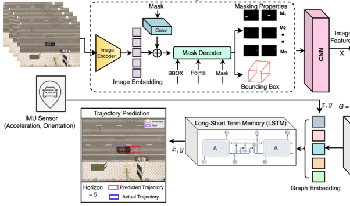
Predicting the trajectory of an ego vehicle is a critical component of autonomous driving systems. Current state-of-the-art methods typically rely on Deep Neural Networks (DNNs) and sequential models to process front-view images for future trajectory prediction. However, these approaches often struggle with perspective issues affecting object features in the scene. To address this, we advocate for the use of Bird’s Eye View (BEV) perspectives, which offer unique advantages in capturing spatial relationships and object homogeneity. In our work, we leverage Graph Neural Networks (GNNs) and positional encoding to represent objects in a BEV, achieving competitive performance compared to traditional DNN-based methods. While the BEV-based approach loses some detailed information inherent to front-view images, we balance this by enriching the BEV data by representing it as a graph where relationships between the objects in a scene are captured effectively.

The demand for object tracking (OT) applications has been increasing for the past few decades in many areas of interest, including security, surveillance, intelligence gathering, and reconnaissance. Lately, newly-defined requirements for unmanned vehicles have enhanced the interest in OT. Advancements in machine learning, data analytics, and AI/deep learning have facilitated the improved recognition and tracking of objects of interest; however, continuous tracking is currently a problem of interest in many research projects. [1] In our past research, we proposed a system that implements the means to continuously track an object and predict its trajectory based on its previous pathway, even when the object is partially or fully concealed for a period of time. The second phase of this system proposed developing a common knowledge among a mesh of fixed cameras, akin to a real-time panorama. This paper discusses the method to coordinate the cameras' view to a common frame of reference so that the object location is known by all participants in the network.

Advanced perception and path planning are at the core for any self-driving vehicle. Autonomous vehicles need to understand the scene and intentions of other road users for safe motion planning. For urban use cases it is very important to perceive and predict the intentions of pedestrians, cyclists, scooters, etc., classified as vulnerable road users (VRU). Intent is a combination of pedestrian activities and long term trajectories defining their future motion. In this paper we propose a multi-task learning model to predict pedestrian actions, crossing intent and forecast their future path from video sequences. We have trained the model on naturalistic driving open-source JAAD [1] dataset, which is rich in behavioral annotations and real world scenarios. Experimental results show state-of-the-art performance on JAAD dataset and how we can benefit from jointly learning and predicting actions and trajectories using 2D human pose features and scene context.

The demand for object tracking (OT) applications has been increasing for the past few decades in many areas of interest: security, surveillance, intelligence gathering, and reconnaissance. Lately, newly-defined requirements for unmanned vehicles have enhanced the interest in OT. Advancements in machine learning, data analytics, and deep learning have facilitated the recognition and tracking of objects of interest; however, continuous tracking is currently a problem of interest to many research projects. This paper presents a system implementing a means to continuously track an object and predict its trajectory based on its previous pathway, even when the object is partially or fully concealed for a period of time. The system is composed of six main subsystems: Image Processing, Detection Algorithm, Image Subtractor, Image Tracking, Tracking Predictor, and the Feedback Analyzer. Combined, these systems allow for reasonable object continuity in the face of object concealment.